A rotary evaporator is a sophisticated laboratory instrument designed for efficient and gentle separation of solvents from mixtures, particularly useful for heat-sensitive materials. It operates on the principles of vacuum distillation, where the boiling point of a solvent is significantly reduced under reduced pressure. The system includes a rotating flask, a vacuum pump, a heating bath, and a condenser. The rotation of the flask creates a thin film of the solvent on the inner wall, increasing the surface area for evaporation and ensuring uniform heating. This process minimizes the risk of bumping and allows for rapid and efficient distillation. The solvent vapor is then condensed and collected in a separate flask, while the vacuum system maintains the reduced pressure environment throughout the process. This makes rotary evaporators ideal for handling volatile and heat-sensitive compounds, preserving their chemical integrity.
Key Points Explained:

-
Principle of Vacuum Distillation:
- The core science behind a rotary evaporator is vacuum distillation. By reducing the internal pressure using a vacuum pump, the boiling point of the solvent is lowered. This allows solvents to evaporate at much lower temperatures than they would under normal atmospheric pressure, which is crucial for preserving the chemical structure of heat-sensitive materials.
- For example, solvents with high boiling points, such as water or dimethylformamide, can be distilled at significantly lower temperatures when the vacuum is reduced from 760 torr (atmospheric pressure) to 5 torr.
-
Role of Rotation:
- The evaporation flask rotates at a constant speed, creating a thin, uniform film of the solvent on the inner wall of the flask. This rotation serves two main purposes:
- Increased Surface Area: The thin film maximizes the surface area exposed to heat, accelerating the evaporation process.
- Uniform Heating: The rotation ensures even distribution of heat, reducing the risk of localized overheating and preventing bumping (sudden, violent boiling).
- The evaporation flask rotates at a constant speed, creating a thin, uniform film of the solvent on the inner wall of the flask. This rotation serves two main purposes:
-
Heating and Evaporation:
- The evaporation flask is partially submerged in a heated liquid bath, which provides controlled and consistent heating. The combination of reduced pressure and uniform heating allows the solvent to evaporate efficiently without degrading the solute or analyte.
- The evaporated solvent forms a vapor, which is then directed through a vapor duct.
-
Condensation and Collection:
- The solvent vapor is cooled and condensed back into a liquid using a glass condenser. The condenser is typically cooled with a circulating coolant, such as water or a refrigerant.
- The condensed liquid is collected in a separate receiving flask, effectively separating it from the original mixture.
-
Vacuum System:
- A vacuum pump maintains the reduced pressure environment throughout the distillation process. The vacuum level is carefully controlled to achieve the desired boiling point reduction, typically operating at pressures between 1 torr and 600 mmHg, depending on the solvent and application.
- The vacuum system also ensures that the process remains efficient and minimizes the risk of contamination or solvent loss.
-
Applications and Advantages:
- Rotary evaporators are particularly suited for:
- Volatile Solvents: They can safely handle solvents with low boiling points.
- Heat-Sensitive Materials: The low-temperature distillation preserves the integrity of delicate compounds.
- Efficient Separation: The combination of vacuum, rotation, and controlled heating allows for rapid and efficient separation of solvents from mixtures.
- They are widely used in chemistry, pharmaceuticals, food science, and environmental testing.
- Rotary evaporators are particularly suited for:
-
Key Components:
- Rotary Flask: Holds the sample and rotates to create a thin film for evaporation.
- Heating Bath: Provides controlled heating to the flask.
- Vacuum Pump: Reduces pressure to lower boiling points.
- Condenser: Cools and condenses the solvent vapor.
- Receiving Flask: Collects the condensed solvent.
By combining these principles and components, a rotary evaporator offers a precise, efficient, and gentle method for solvent separation, making it an indispensable tool in modern laboratories.
Summary Table:
| Key Component | Function |
|---|---|
| Rotary Flask | Holds the sample and rotates to create a thin film for evaporation. |
| Heating Bath | Provides controlled heating to the flask. |
| Vacuum Pump | Reduces pressure to lower boiling points. |
| Condenser | Cools and condenses the solvent vapor. |
| Receiving Flask | Collects the condensed solvent. |
Discover how a rotary evaporator can enhance your lab's efficiency—contact us today!











